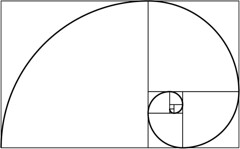
By the Hungry Hungry Hipster
The golden ratio (also known as the golden mean, the golden section, and the divine proportion) is where math and art intersect. It has been applied to proportions in art and architecture since the ancient Egyptians built their pyramids and when the ancient Greeks built their temples (see the Parthenon). It had a rebirth in the Renaissance and has been used in design ever since. It is used because the human mind finds this ratio (1.61803398874989) aesthetically pleasing. Why? It could be because the golden ratio is frequently found in nature, especially through Fibonacci numbers, which are an integer sequence of numbers where “the first two numbers in the Fibonacci sequence are 0 and 1, and each subsequent number is the sum of the previous two” (Wikipedia). Select any two successive (one after the other) Fibonacci numbers and their ratio is extremely close to the golden ratio.
Here is a good article that gives examples of the golden ratio in nature. And here’s another good site that talks more about the math side in nature.
The rule of thirds, when applied to photography and graphic art, makes the image more interesting to the eye. It is a compositional rule of thumb where “an image should be imagined as divided into nine equal parts by two equally spaced horizontal lines and two equally-spaced vertical lines” (Wikipedia). When elements in the image align with or intersect these lines and intersections, in theory more visual tension and energy is created within the overall image.
Many people believe utilizing the rule of thirds makes a photo or work of art more visually appealing then centering a subject in the middle. Many digital cameras now offer a rule of thirds grid overlay in their LCD viewfinders, giving you the ability to apply the rule of thirds to your photos on the fly. If your camera doesn’t have that feature, you can always utilize the rule of thirds when you crop the photo.
Also, artists use the rule of thirds “so that a viewer looks in that direction first. It has been proven that the human eye looks at some key structures when they look at paintings” (Wikipedia).
There are two types of perspective: graphical and visual. Graphical perspective is an artistic technique that gives two-dimensional art the illusion of depth and three dimensions. It mimics the way objects appear to the eye, which is called visual perspective. In both visual and graphical perspective, lines recede into a vanishing point. When applied to the Catch photo, perspective doesn’t give a 3D illusion to the photo — it’s just that elements in the photo happen to be at angles that all meet at a vanishing point, giving it a perspective-like effect. This can make an image look more appealing, because our eyes are accustomed to seeing in perspective, so when we view an image that shows perspective-like characteristics, we recognize it subconsciously. It is only when we actually put lines over the work of art that we notice this effect with the conscious mind.